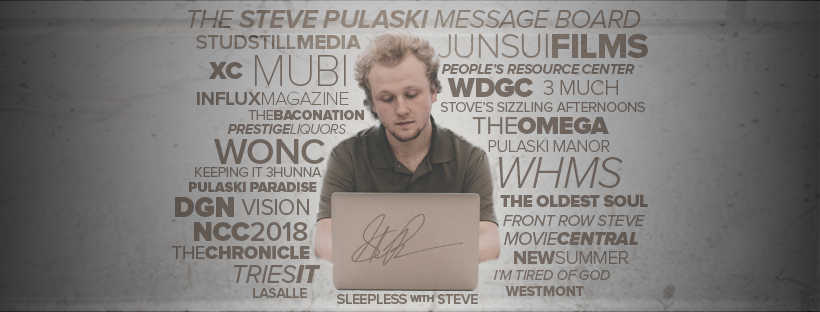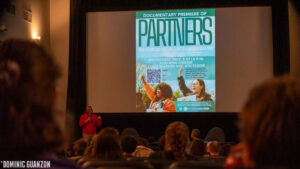Publication Date: 11-23-2025
Partners: How Starbucks Baristas Started a Labor Revolution (2025) review
Dir. Chris Sessions
By: Dominic Guanzon
Rating: ★★★½
NOTE: Dominic Guanzon has been the co-host of my podcast, Sleepless with Steve, since its inception in 2016. Dominic is as active in the landscape of Chicago politics as anyone I know, and also runs an Instagram account known as “Blue Collar Jazz.” He recently attended a screening of a documentary called Partners: How Starbucks Baristas Started a Labor Revolution in Chicago. I implored him to write a review for my website.
During one of my excursions to the ICE Staging Area/de facto detention center in Broadview, IL, I got to talking with one of the volunteers working the mutual aid station that had been camped out and occupied 24/7 for a month. That is, until its removal via malicious enforcement on 10/30 by the village of Broadview.
Regardless, the station’s two tents provided a plethora of valuable services for those protesting just a couple hundred feet away. They included eye flushing for people struck with tear gas, water, snacks, first-aid, shade to stay cool, campfire to stay warm, protective gear to loan out, a notice board for protest information elsewhere, a rallying point for groups, and simply a place to rest.
As intense as it all was, the volunteer I spoke with was used to dispensing food and water, since they had a background as a Starbucks barista. That’s when I found out about how much of a phenomenon it has been for the corporate coffee colossus to unionize. Since 2021, the number of unionized shops has risen to 655 out of approximately 18,300 stores in the US. That’s over 14,000 workers now part of that union, according to UnionElections.org, with more elections happening every month.
The mutual aid volunteer then pointed me towards a screening of the documentary Partners: How Starbucks Baristas Started a Labor Revolution at Columbia College’s Film Row Cinema in The Loop. Not wanting to miss a good, and true, underdog story, I headed downtown.
Located on the eighth floor of 1104 S. Wabash Ave, I stepped out of the elevator to a theatre lobby buzzing with energy. It turns out that a potential nation-wide strike was in the works, should contract negotiations fail. The timing couldn’t be more appropriate, since Red Cup Day was just eight days away. For those who are unaware, Red Cup Day is when Starbucks starts selling a limited-edition, holiday-themed, plastic cup. The whole thing is an annual corporate tradition to drum up sales that inevitably pisses off conservatives for not flaunting a Crusader knight battling a woke, or something.
There was a table for union organizing in the theater lobby, as well as a plethora of free buttons, flyers, and other protest paraphernalia for a variety of issues; from Palestine to trans rights. Solidarity forever, indeed.
About 50 people came out, which was pretty good for 6PM on a Wednesday night, and as one might think, the majority of the crowd skewed young, but with a smattering of older people there too.
A fired-up union organizer introduced the movie proper, reminding the audience what’s at stake. “An injury to one is an injury to all,” he declared.
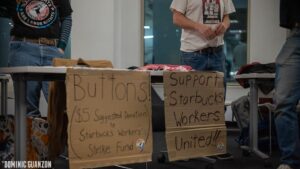
Organizers tabling in the theater lobby. Film Row Cinema, 11/5/25. Photo by Dominic Guanzon.
The documentary centers around a motley crew of about a dozen 20 to 30-somethings at three stores in Buffalo, New York. Prominently featured is Jaz Brisack, who was one of the central “salts” to start the union and put the plot in motion.
In the labor context, salting is the act of joining a job with the specific intent of starting a union. In Brisak’s case, that meant learning how to make and serve coffee, at one point blogging their way through it.
Brisack had been organizing at various places, such as Nissan with the United Auto Workers (UAW), when they were as young as 20 years old. When they joined Starbucks in 2020, it was in the midst of COVID, and the people making America’s mocha frappes were considered essential workers.
The rest of the baristas pop back and forth into the spotlight in slickly-edited interview snippets for whatever stage of the plot we’re in, often to humorous effect with their anecdotes. Like the theater audience, they’re what you’d think a bunch of young coffee servers would look like, many of whom work in entertainment. At one point, one of them even says if there was a Venn diagram of people who work in that industry, it would consist of gays, cat-owners, and Starbucks workers.
They’re energetic, sassy, and I wouldn’t be surprised if a couple were on the spectrum (gang gang). It’s all right at home for the audience this is meant for. But even if you’re the kind who finds those cultures annoying, it doesn’t lay it on too thick. First and foremost is the union story. It’s just funny, and honestly refreshing, to see labor theory take hold in such an unlikely space.

Official poster of the film.
One of the baristas, Michelle Eisen, is a theater production worker who turned Starbucks into a career for 14 years. During that time, she witnessed how the “company shifted dramatically,” turning the third place that’s supposed to be a coffee shop, into a fast-casual corporate money-maker that saw conditions deteriorate.
30-hour schedules turned to 10 hours. COVID pay, the compensation you’d get if you were out with the virus, was taken away. Another server explained how they were expected to make 30 drinks in five minutes, which came out to about $140 in profit, but with only 45 cents of that going to the workers who actually made those drinks.
Enter Richard Bensinger, a long-time labor organizer associated with major units such as the SEIU, AFL-CIO, and Workers United, the last of which will be the main anchor for this Starbucks saga.
Bensinger met Brisak during UAW organizing, and in 2020, it led to not just the documentary’s story, but some of the raw footage as well.
“I just started documenting it,” he explains, with the film cutting to discussions around a dining room table, papers, notebooks, and office supplies all out to help build to and plot the moment when they’d officially petition to the National Labor Relations Board (the government agency that handles union affairs) for an official vote. Things were getting serious, and they’d have to be if they were going to take on one of largest, most corporate restaurant companies in America.

Title card from the film’s website.
Anti-labor practices, aka union busting, is a great American tradition going back well over a hundred years.
Here in Chicago, back in 1894, labor activists within the Pullman Company fought back against worsening conditions, low wages, and strange, controlling behavior amongst the company-owned housing. The Pullman Strike brought together about a quarter of a million workers, but it was put down by the US Army, resulting in dozens of deaths.
The government gave us Labor Day as a compromise.
The documentary does not go into this or similar incidents, thank goodness, since it would have been out-of-place. However, the implication looms over the raw energy that exudes from these baristas. Mentions of the IWW are prevalent, cuts to red-and-black posters adorn offices, and the end credits use a labor folk song.
Starbucks’ union-busting efforts are a lot less dramatic than Pullman’s, but they are exponentially more embarrassing.
After the coffee workers established a union office, gathering signatures, holding meetings, and finally petitioning the NLRB for three small Buffalo locations, both the pressure and cringe ramped up.
The Saturday after the announcement, a woman from high up the corporate ladder appeared at the union-hopeful shop. Enter Rossann Williams, the president of retail for the company in North America. She appeared in the store without warning, picked up a broom, and was filmed sweeping the floors in what seemed like an attempt to appear like a fellow salt-of-the-earth employee, as the real workers continued their day beside her.
The theater crowd erupted into laughter.
The baristas then tell of how a flood of managers (as many as 300) from across the country were flown in by corporate to “spy and disrupt” the efforts. Bensinger attempted to interview one to get some answers, but was immediately shut down, as the outside manager asked that all questions go to Starbucks’ official media.
Then there were the petty things. Baristas were told the pattern on their shirts were too dark. Tip jars were moved away from their usual different spots. The outside managers wore the drive-thru headsets for seemingly no other reason than to listen in on communications, as if secret union plans would be discussed (the IWW recommends never talking about union business at work or on work devices).
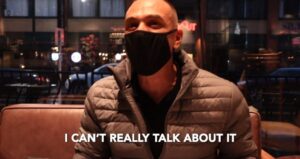
Screengrab from the film’s trailer, showing an outside manager brought to Buffalo by Starbucks corporate, allegedly to “spy and disrupt” unionization efforts.
Finally, a series of “partner listening sessions,” which turned into de facto captive audience meetings, were held with the assembled unionizing servers. Williams, other corporate drones, and then-CEO Howard Schultz himself made their case in person.
In a stunning montage, some of it secretly recorded, the back-handed faux-care, emotional manipulation, and Disney-level cultishness was put on full display.
“I’m heartbroken,” Williams declared, followed by other execs declaring as well that the baristas were “breaking my heart,” and that they “love you guys.” At times, they were outright shedding tears to show they were emotionally hurt by the union drive.
“We cared when George Floyd died,” a speaker proclaimed, eliciting disgust from both the documentary subjects and the live theater audience. It was as cringe-inducing as anyone can imagine.
As production manager Eisen said, “I know a show when I see it.” They were “talking to us like children.”
Finally, Schultz himself took the mic in a last-ditch pitch, telling how he grew up in the projects and lived “poor, downridden, destitute.” At one point, he talked about how he “took a trip to Israel” and veered into talking about concentration camps for an unusually long time, which garnered a big laugh from the audience.
“Fuck this guy,” said one theater audience member.
“They’re scared shirtless,” said a barista in the movie.
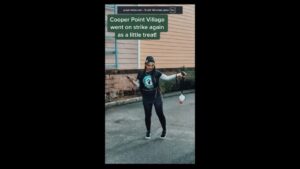
Screengrab from the film’s trailer, showing a Starbucks union member dancing as a store goes on strike.
The documentary then approaches its natural climax: the union vote. Even before then, corporate announced it was raising wages to at least $15 per hour, with seniority pay also starting up as a policy. All this with just the idea of unionization and the inherent bargaining power it holds.
Two weeks before the vote however, two of the three union-potential stores were shut down by corporate, creating an atmosphere of what the labor camp called “corporate terror.”
But as you can guess by the opening paragraph of this review, they succeeded, with a euphoric and media-heavy celebration as the vote count happened live, the film making sure to celebrate with them with its montages.
One of the last words we hear from Schultz pretty much sums up the veneer of choice workers have: “It is the right of Americans to unionize, it is also the right of Americans not to unionize, and embrace the values of his or her company.”
But the movie closes with a hopeful tone, its energy an urging for others to take up the mantle. It also claims Starbucks has been convicted of breaking over 100 labor laws, which is a very believable number.

Partners director Chris Sessions (left) and Starbucks union salt Casey Moore (right). Film Row Cinema, 11/5/25. Photo by Dominic Guanzon.
After the doc’s screening, an interview was held with another original labor salt, Casey Moore, and the Portland-based director Chris Sessions. It was led by a Chicagoland barista-labor organizer, Mel, who had just been fired from her Starbucks job that day.
“This morning when I talked into work at 5AM, in an act of clearly retaliatory union busting, I was fired from my job at the unionized location in Glenview, Illinois, at Willow [Road] and Pfingsten [Road],” Mel opened, with supportive jeers from the crowd.
“Unfair labor violations abound, as the CEO, Brian Nickel, continues to stall in negotiating with us for a fair contract. Our union members just initiated a nationwide strike vote, and we are rallied and ready to act if Starbucks refuses to come back to the table with a realistic offer.”
The audience burst out in applause.
Sessions began the interview, going into how the documentary came about spontaneously as a group effort. “I think what’s really special about this film is that it started with Richard [Bensinger], and Michael Sangria, a barista, thinking that it might be smart to document what was going on. They didn’t have a clear direction with where that was going to go, but they started filming and collecting item footage. And then other baristas started filming things and recording captive audience meetings and collecting news.
“There was this really cool bank of footage. I was there for one day during the [union] campaign…and then a couple of years later, in 2023, Richard and I got in touch, and we started putting the film together.”
Sessions also describes how he wore multiple hats during this time, filming the documentary while also assisting with labor organizing at various businesses while in Buffalo, including Hyatt Hotels, Tesla, and Elmwood Tacos and Subs.
“It was cool because as the film was coming together, I would be in Buffalo, editing in my hotel room and collecting footage, and then coming out and helping us with these campaigns. I’m a filmmaker, not an activist, but obviously it’s not a neutral film, and I think that’s a good thing.”

10-year Starbucks barista and local union organizer Mel, who was fired from her store job the same morning. Film Row Cinema, 11/5/25. Photo by Dominic Guanzon.
Casey Moore talked about what is like salting and the decision to pull the trigger and do it. “The line is very blurred, right? Like we say, there were no other organizers, but like, how many people saw the campaign and were like, ‘oh shit, that’s cool.’ Like, I’m going to get a job at Starbucks now because I will be a part of a union. Like, is that salting?
“When I was talking to Richard on the screen, when I was living in Philly at the time, deciding whether to move up to Buffalo, what he told me was that salting is one of the most noble things you can do. It’s one of the most important things, and I couldn’t agree more. I think in this moment that we’re in right now, organizing at the workplace is one of the best ways to fight fascism and authoritarianism,” she said, to applause.
“I think the thing that we didn’t go too in-depth in the film, is that the reason we had salt in the first place is because this was a geographic organizing project to organize the coffee industry. We organized SPoT Coffee [a Buffalo-based chain] and there had been a big boycott fight. We won the right to organize there, and the idea was that you can’t just organize the local SPoT Coffees. You have to organize their competition. What’s that? Starbucks?
The idea was, okay, we need to be strategic about this, and we need to be able to identify the leaders, have conversations with them, and inoculate and do the underground organizing before we go public with our campaign. And that’s the role we played: a salt.
I wasn’t the leader at my store at the beginning. Michelle [Eisen], was the leader at the store who’s been there for ten plus years. So my job wasn’t to lead the campaign. It was to identify the hooks that were already there, and already had the skill set, and a desire to do so, but maybe just didn’t have the confidence or the resources.”
“So that’s what salting is. It’s just being the spark, but not necessarily being a leader. By the time I left, Starbucks had gotten rid of so many people that I did have seniority. So I was a natural leader at that point, but not the beginning.”
Moore then pivoted to a plug called the Inside Organizer School, which she and Brisak are a part of. The group effectively trains salts to do what she and Brisak did at Starbucks.
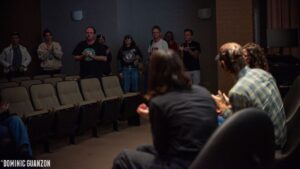
The panel and audience congratulate Mel for her labor efforts. Film Row Cinema, 11/5/25. Photo by Dominic Guanzon.
Mel closed the interview with a question on what the duo thought about the resurgent labor movement:
“I think it’s tremendous,” Sessions answered. “I think Starbucks knew, as well as the baristas, that it would only take one store. I remember a phrase that was thrown around: ‘this is why they put so many resources into trying to stop that one store.’ Now, Starbucks stores have organizers that have permeated to Chipotle and REI. I think it’s opened up this door to the service industry.
Looking at the history of Buffalo, which used to have almost 100% union density, it was manufacturing industries and textile industries. These were good, well-paid jobs, because there was this industrial organizing where the entire industry came together. Those jobs are gone and replaced by conservative factory guys. Which, you know, there’s no reason that they’re paid less, there’s no reason there’s no union there. It’s just that they haven’t been organized…And so I think Starbucks Workers United was remarkable in that way.”
“I think the Starbucks campaign helped bring unions to a whole new generation of people,” said Moore.
“I think that that’s incredible. And I think Starbucks workers who have been a justifier. ‘If you guys are gonna go, we’re all gonna go to our next workplace and continue organizing because we now have that skill set, a mindset.”
“Why was [the first unionized Starbucks] a huge moment? There’s a lot of factors, but most people in the US have this connection to Starbucks. And so it was a symbol.”
The assembly ended with various calls to action from Mel, including fund collection for the potential strike. When she was done, another organizer took the mic, and asked for a recognition of Mel herself, who “worked at Starbucks for ten years. She put so much energy, and dedication into organizing her store, and put herself at risk to do that.”
The crowd responded with a long, thunderous applause.
“That’s the fifth time I’ve cried today,” she half-joked, “but only because I am nervous. Because I love my job. I really loved it. I love my customers. I love my job. So…let’s win this contract!”
Afterwards, the audience made their way back to the theater lobby to enjoy food provided for free from a certain local pizza place, which was announced as such.
However, another person was quick to chime in that one of their stores has faced labor-related trouble. I won’t say the name since I can’t verify the information in a timely fashion, but it’s another example of how politicized something as mundane as pizza or coffee can be.
And maybe, at this point, it just needs to be.

Starbucks Workers United buttons on a table in the theater lobby. Film Row Cinema, 11/5/25. Photo by Dominic Guanzon.
Partners is a documentary that’s as quick and digestible as a well-organized Starbucks. It’s also just as important as a well-unionized Starbucks.
I do think it was a missed opportunity to not show just how grueling a restaurant job can be. Service workers, especially baristas, still have this debilitating stigma of being in an easy position, as if every day was as simple and inconsequential as Clerks. This, compared to the blue collar America of plumbers, electricians, construction workers, and lumberjacks!
But the Millennial and Gen Z generation knows first-hand just how ridiculous of an assertion that is, and funny enough, the Starbucks union was one of the first to really take that image, break it, and turn it into meaningful victories for thousands of salt of the earth people.
There may have also been an interesting angle to get a statement from a barista that voted “no,” even if done anonymously. If I’m remembering things right, we only ever see the “yes” voters, but hearing first-hand what drives workers to vote against their interest may be of value to future organizers.
I also would have personally liked to have seen more time taken to show the minutiae of paperwork, signature-gathering, letter-writing, and other mundane aspects of unionizing. But that’s the All The President’s Men fan in me, and I understand this film needed to keep the energy up. This movie trades total realism for the mission, the message, and the vibes.
Partners is, first and foremost as Sessions himself alludes to, labor propaganda. It’s worker biased. It’s union slanted. It’s meant to be mass consumed by a wide audience, all in the time it takes to wait for your friend to finally show up to your coffee meeting and begin discussing unionizing your job.
And in a world exponentially terrorized by billionaires and their hoarded gold, it’s what’s desperately needed.
Read more about Partners on the film’s official website. Follow Dominic Guanzon on Instagram.
About Steve Pulaski
Steve Pulaski has been reviewing movies since 2009 for a barrage of different outlets. He graduated North Central College in 2018 and currently works as an on-air radio personality. He also hosts a weekly movie podcast called "Sleepless with Steve," dedicated to film and the film industry, on his YouTube channel. In addition to writing, he's a die-hard Chicago Bears fan and has two cats, appropriately named Siskel and Ebert!

